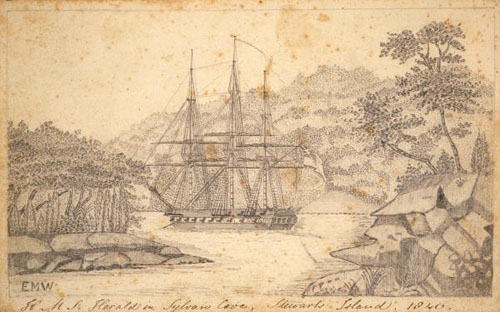
A
portrait of HMS Herald lying at anchor in Sylvan Cove, Stewart Island, drawn by
Edward Marsh Williams, 1840.
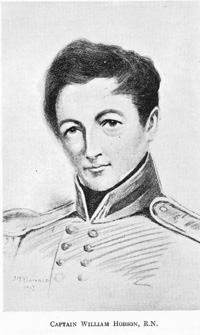
January
29th 1840...
Lieutenant Governor Hobson arrives in New Zealand
aboard the HMS Herald, having been sent by the Colonial Office with a very comprehensive
brief. This brief relates to the explicit
conditions of a signed Treaty being entered into with the Maori Chiefs of New
Zealand and their willing ceding of the Sovereignty of their country to Queen
Victoria. These conditions constituted basic requirements that had to be attained
before Britain was prepared to declare New Zealand to be a British Colony.
James Busby, New Zealand Resident (The highest British authority) comes aboard
HMS Herald, then lying at anchor at the Bay of Islands, and immediately enters
into consultation with Hobson in Hobson's cabin. Accompanying Busby to the ship
was Mr. Charles Baker, missionary, who in the temporary absence of Henry Williams
(head missionary), was in charge of the Paihia Mission Station and printing press.
Henry Williams would return and have meetings with Hobson on the afternoon of
the 1st of February, 1840.
James Busby is informed that
his official position as Resident is being superseded and that Hobson has been
declared Lieutenant-Governor over "such part of that colony in New Zealand
as might be acquired in sovereignty".
A letter
(and accompanying "notice" document) from Hobson are despatched to Charles
Baker, who had gone ashore while Hobson and Busby were in consultation. The letter
requests that a draft invitation, for the Chiefs to attend a meeting, be printed
and distributed to them by messengers. James Busby is in possession of the letter
and draft invitation and gives them to Baker when he comes ashore.
Mission printer, William Colenso, works well into the night to have 100 "notices
of a meeting" (by now translated into Maori) printed and ready for circulation
by messengers. The invitations are signed by Busby and invites the chiefs to assemble
at his house the following Wednesday. The chiefs will there meet Lieutenant Governor
William Hobson and listen to his proposal from Queen Victoria.
January 30th 1840...
The
printed invitations are sent by messengers to the chiefs.
Hobson
comes ashore in full dress uniform and, at the Kororareka church, reads out his
Commission from Queen Victoria and a "Proclamation", which effectively
disclose the reason for his presence in New Zealand. 'At the church the residents
were gathered, probably in greater numbers than ever before, and heard the proclamation
informing them that the Queen's Writ had come to the bay and that as one of its
implications no further land purchases from the natives would be recognised as
valid. During the next few days there was much debate in Kororareka, for Hobson's
announcement of his policy with regard to land purchase was most disturbing to
land speculators' (see William Colenso, by Bagnall & Peterson, pg.
90).
January 31st
to February 5th...
This period of time is devoted to drafting
the English text that will become the Maori Tiriti O Waitangi - Treaty of Waitangi,
the wording of which has to comply to the stringent requirements of the Colonial
Office. Of this exercise a historian writes: "The exigencies of the position
demanded that the greatest care should be exercised in framing the terms of the
document...The number and extent of the erasures in the original draft indicate
that the greatest care was taken in its composition by those concerned' (see The
Treaty of Waitangi, by T.L. Buick pg. 109).
February
1st 1840...
At about this time the rigours of extended voyages
and the stress related to official responsibilities over a considerable period,
cause Hobson to be quite run down and tired.On this evening he has a "terrible
row" with Captain Nias and is sickened by stress in dealing with the Captain.
He begins to experience the first symptoms of a stroke, which will kill him within
3-years. On the 2nd of February he will be confined to his cabin aboard the Herald
for much of the day and it becomes apparent to him that he has to delegate the
task of writing the treaty to Busby. He, therefore, has the principal member of
his staff, Mr. George Cooper, take his rough treaty draft notes, together with
a request that James Busby give him an opinion as to the suitability of the document.
These notes have been written up by both Hobson, initially, and later J.S. Freeman,
Hobson's secretary, who has also created a Preamble text of his own.
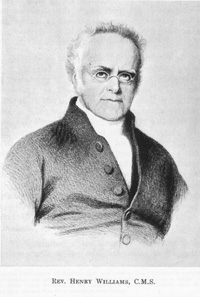
Head missionary, Henry Williams returns at haste from Waimate and goes aboard
the Herald to meet with Hobson. This early reunion with Williams, whom Hobson
had met in 1837 when visiting New Zealand as captain of H.M.S Rattlesnake, is
a pleasant surprise to Hobson. Williams assures Hobson of his hearty support in
the purpose of establishing Her Majesty's authority in New Zealand and offers
his assistance in any capacity for which he can be of service. One historical
account has Henry Williams arriving back as early as the 30th of January.
February 2nd to February
3rd 1840...
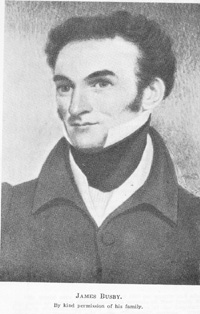
It
would appear that George Cooper, while attending church at Paihia with Felton
Mathew, gives the rough draft treaty notes to Busby on this day. Busby has no
hesitation in saying that they are quite unsuitable in their wording to accomplish
the objective. Busby is making a judgement, based upon his 7-years of experience
as Resident and his long-term association with the Maori people. Because of Hobson's
illness, Busby assumes the task of organising, clarifying and rewriting the document
from the existing rough notes. During the afternoon / evening of the 2nd and throughout
the entire day of the 3rd of February he devotes time to fleshing out, Articles
I, II & III and creates an extensive Consent and Signing section. This approximate
layout, with some scant ideas for Articles was, originally, conceived by Hobson
and J.S. Freeman. Some preliminary ideas for the articles are found amongst Freeman's
notes. On the 3rd and 4th of February, both Hobson and Busby, working with other
advisors, will complete the final draft (the Littlewood Treaty). J.S. Freeman
(Hobson's secretary), J.R. Clendon and an individual named Brown are also said
to have had some input in these final drafting stages, leading to the finished
treaty (see, Shadow of the Land, by Government Historian, Ian Wards,
Wellington, 1968, pg. 42). Rev. Henry Williams appears to have played a prominent
role throughout the entire drafting process and all the senior CMS or Wesleyan
missionaries act in an advisory capacity.
In the afternoon
of the 2nd of February, Felton Mathew and others of Hobson's staff take Hobson
to view Busby's 2-room cottage at Kororareka. This cottage is located on the opposite
side of the bay to where Busby has his official residence at Waitangi. It seems
apparent that, during Sunday morning, something has been said to Busby by Felton
Mathew and George Cooper about Hobson's stress related illness. Busby, it would
seem, suggests that Hobson use his Kororareka township, two-room cottage. It's
very important that Hobson distances himself from further arguments with Captain
Nias aboard H.M.S. Herald if he is to succeed in finalising the treaty draft before
the meeting on the 5th of February.
February
3rd 1840...
Sailors of the Herald begin labouring ashore
under the direction of Lieutenant Fisher, to create a large marquee, with a framework
of ship's spars and a covering of ship's sails. This huge tent structure, erected
on the front lawn of Busby's official Residency, is 150 feet long and 30 feet
wide. A series of smaller tents are set up around the larger one. These are for
the shelter of Maori who, for reasons of inferior rank or otherwise, might not
be able to find a place within the larger structure. The large marquee has a raised
platform at one end and an impressive table overlain with a large Union Jack flag.
Hobson
goes ashore in the afternoon and stays ashore overnight at Busby's cottage. James
Stuart Freeman, Hobson's secretary, records the location from which he writes
his afternoon despatch as Kororarika, Bay of Islands.
Busby
meets with Hobson at Kororareka and submits his rough treaty draft, which he has
been working on during the afternoon of the 2nd and most of the day on the 3rd.
During the day he has produced a corrected copy of his earlier effort and this
is the version he brings to Hobson. They meet at Busby's cottage at Kororareka
and, by the following day at least, discuss a rental price, per annum, for the
premises.
On the evening of the 3rd, there is still quite
a lot of work to do in creating a treaty document that conveys the exact meanings
required by the Colonial Office. Busby has forgotten to word his draft so that
it is directed toward the rights of "all the people
of New Zealand"and
not just the Chiefs and tribes. Work will continue on the final
English draft tomorrow and it will be completed then. To view Hobson's/Freeman's/
Busby's rough notes, completed up to this stage of development (3rd of February
1840) and also the final draft of the 4th of February, CLICK
HERE.
February
4th 1840...
Hobson's final English draft of the Treaty of
Waitangi is written up during the day on paper which bears a W. Tucker 1833
watermark. The only individual known to be using this paper in New Zealand during
1839 to 1841 was James Reddy Clendon. As U.S. Consul, most of his despatches
to the U.S. Secretary of State throughout this period include letters or reports
written on W. Tucker 1833 paper. All available evidence points to the fact
that the final drafting session took place at Clendon's Okiato home, with Clendon
advising and supplying the paper. The final text wording is written by James
Busby under the direction and approval of Lieutenant Governor Hobson.
Busby dates the document the 4th of February 1840.
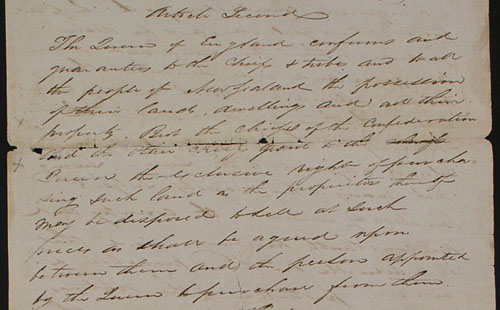
Article
II of the final draft in English of the Treaty of Waitangi, written by James Busby
on J.R. Clendon's W. Tucker 1833 paper stock and dated the 4th of February 1840.
U.S.
Consul, James Reddy Clendon takes this opportunity to transcribe a copy of Busby's
final draft for later despatch to his American superiors, should the British be
successful in securing a treaty.
The available evidence points
to the fact that the final draft was written at Clendon's Okiato estate, which
is very convieniently located only a short distance by water from the C.M.S. Mission
at Paihia (present day Te Haumi). Hobson goes to missionary Henry Williams
and hands him the final English treaty document at 4pm in the afternoon. Hobson
asks Williams if he would be good enough to translate the document into the Maori
language for presentation to the chiefs by the morning. Williams commences the
translation with the expert assistance of his son Edward, who is considered to
be a scholar, par excellence, in the Nga-Puhi dialect. Henry Williams
has, by this time, been a missionary in New Zealand for 17-years and is a very
fluent speaker of the Maori language and an adept, seasoned translator. Edward,
having been raised in a predominantly Maori community, is exceptionally fluent
in the Maori tongue.
February
5th 1840…
Every effort is made to perfect Williams'
Maori translation document right up until the last minute. Of the finished Maori
version a historical account says: 'Upon its completion the work was revised
by Mr. Busby, who suggested the elimination of the word Huihuinga used by the
translators, and the substitution of Whakaminenga more adequately to express the
idea of the Maori Confederation of Chiefs' (see The Treaty of Waitangi,
by T.L. Buick, pg. 113).
Once the paper draft, in Maori,
is completed (with a correction) the text is to be accurately transcribed (after
the meeting on the 5th) to the final (parchment) document (upon which signatures
are written on the 6th). Lieutenant Governor Hobson later states that this final,
carefully considered Maori wording is, 'de facto the treaty, and all the signatures
subsequently obtained were merely testimonials of adherence to the term of the
original document' (see The Treaty of Waitangi, by T.L. Buick, pg. 147).
At
nine o'clock the Lieutenant Governor, accompanied by Captain Nias of H.M.S. Herald,
lands at Waitangi (seemingly for the very first time) and at once goes to Busby's
residence. Prior to the commencement of proceedings, Hobson consults with Resident
James Busby, Rev. Henry Williams and the Rev. Richard Taylor. Bishop Pompallier
arrives at 10: 30 am and makes a grand entry, dressed in "full canonicals".
At
midday Hobson and his entourage, including a somewhat disgruntled Bishop Pompallier,
take their seats on the platform. The finely attired chiefs find the best vantage
positions, facing the British dignitaries. Five yards of space are kept clear
between the platform and the sitting chiefs to allow orators to move and gesticulate
while making presentations. Hobson rises and delivers a carefully prepared speech,
using extensive notes. After explaining the reason for a Treaty and its benefits
to the people of New Zealand, both Maori and settlers alike, Hobson reads the
English version of the Treaty to a large assembly composed of both Maori and Europeans.
His address is followed by Rev. Henry Williams, who reads the Maori version of
the Treaty.
Dr. Phil Parkinson of the National Archives expresses the belief
that the English version, read to the assembled crowd by Hobson, was the Littlewood
Treaty. [Busby's final draft] (Letter from Dr. Phil Parkinson to Martin
Doutré, 24/12/03).
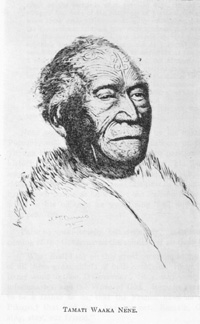
The chiefs rise, each in their turn and speak, with arguments for and against
the Treaty and this process continues throughout the afternoon, interspersed with
explanations from the platform in response to the questions and challenges of
the chiefs. When the debate seems to be going quite badly for the British, Chief
Tamati Waaka Nênê turns the meeting around and influences the assembly
to accept the Treaty. The meeting endures until 4 o'clock, after which time Hobson
returns to H.M.S. Herald. The chiefs had requested time to talk amongst themselves
and enter into hui discussions, which are to endure through much of the night.
The Rev. Henry Williams, as well as others of the missionaries, is in attendance
at the hui to explain and clarify the wording of the treaty document and finite
meanings. It was initially expected that the earliest that the chiefs would reconvene
with a decision would be on the 7th of February.
Richard
Taylor writes in his diary, 'The Governor told them he did not wish them to
sign in haste and appointed a second meeting for the seventh, but when he had
left I thought it most likely nine-tenths of them would leave for their respective
homes. I therefore sent a message to him and told him I would remain until I received
his reply to give notice of the meeting being held the next day. His reply was
favourable and the rough copy of the treaty [Maori text] was sent to me
to get copied...I sat up late copying the treaty on parchment and kept the original
draft for my pains' (see The Treaty of Waitangi, by T.L. Buick, pg. 150).
February
6th 1840...
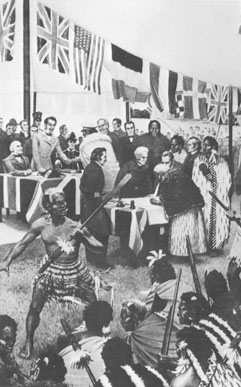
The
signing ceremony of the Treaty of Waitangi. The Chiefs had met in a lengthy hui
discussion at Mii marae after the meeting of the 5th and had decided to sign the
Treaty during the early hours of the morning on the 6th of February 1840.
During
the night the chiefs have decided to sign the Treaty and ask Henry Williams why
there is any need for further delay. Hobson, however, has not been informed of
this early decision, until after two officers, who had gone ashore at about 10
o'clock, are told that the assembled crowd are awaiting the arrival of the Governor.
They explain that, "His Excellency certainly knew nothing of a meeting
to be held here this day". Hobson is quickly summonsed and is obliged
to come ashore so hurriedly that he arrives in civilian clothes, instead of his
full dress uniform. The signing of the Treaty on the 6th has taken him completely
by surprise and he is totally unprepared for the auspicious event. Upon arrival
ashore he says that he "had not entertained the least notion that a meeting
was to be held; that as matters stood he was quite prepared to take the signatures
of all the chiefs willing to sign, but that they still must hold a public meeting
on the following day, as already announced by him'.
Hobson,
once having regained some degree of composure convenes the meeting after a table
is hurriedly supplied, upon which the Treaty document can be lain for the chiefs
to sign. After the treaty document is reread to the assembled chiefs, tribes people
and settlers, Hone Heke steps forward as the first of the chiefs to sign the Treaty
of Waitangi. During the proceedings 43 chiefs sign the treaty, including some
who had not been in attendance the previous day.
February
7th 1840...
Although Governor Hobson has scheduled a meeting
for this day, the skies open up with an incessant downpour, sufficient to dispel
any hope of a meeting. The day is utterly uneventful.
February
8th 1840...
The Union Jack flag is raised at Waitangi and
a 21 gun salute fired to commemorate the cession to Her Majesty of the right of
Sovereignty of New Zealand.
On this day the "store ship",
the Samuel Winter, leaves the Bay of Islands at noon carrying Hobson's first despatch
outlining all of the treaty proceedings and announcing that a treaty has been
secured in a region of the North of the Northern Island. In this despatch is a
handwritten copy of the Treaty in Maori for Governor Sir George Gipps, penned
by Reverend Henry Williams (See Vol. G / 30-1, National Archives of New Zealand,
Wellington).
February 9th
Hobson
and others of his delegation make preparations to go to the Hokianga district
to attend treaty signing assemblies there They head out on the 11th of February.
February
12th
Hobson conducts a major meeting in the Hokianga at which
he secures the signatures of 78 chiefs.
February 14th
Hobson's
delegation return to the Bay of Islands district intent upon sailing in the H.M.S.
Herald for Thames on about the 17th. Unfortunately, Captain Nias, who accompanied
Hobson to the Hokianga District has come down with a bad bout of influenza and
has to stay over at the home of Reverend Richard Taylor at Waimate until he is
better.
February 16th
Hobson takes full
advantage of the "lull" time between his return from the Hokianga and
awaiting to sail to Thames and writes up very extensive reports to be sent in
two separate despatches. He wishes to bring his superiors fully up to date on
all happenings since his arrival in New Zealand. One despatch will go to Governor
George Gipps in Australia and the other directly to Lord Normanby in London, England
February
17th 1840...
The printing press of the Church Missionary
Society prints 200 copies of the Maori version of the Treaty of Waitangi, which
is the only "official" version to be conveyed / presented to Maori prior
to signing. These printed copies are later distributed to all the missionaries
and other parties involved in seeking signatures from the chiefs around New Zealand.
Some of the prints are earmarked for international despatch to foreign governments,
while others filter through the general population of New Zealand and end up in
private collections.
At Treaty gatherings it is this text
alone that is read to the Maori people, prior to debate and discussion. This strict
wording constitutes the solitary compact / contract, the meaning of which is locked
to the meaning of the final English text that has been its "mother"
document.
February17th - 21st
Hobson
wants to head for the Thames, as well as get his two large despatches away to
his superiors in Sydney and London. There have been no incoming and departing
ships, upon which he can send a despatch, since the Samuel Winter left on the
8th, but on the 17th the Martha turns up and it is due to sail to Sydney on the
19th. However, because of a steady and incessant, unfavourable ESE wind the ships
are locked in the bay until the wind changes on the 21st.
This
long stalemate period provides Hobson with ample time to send everything, including
a printed Maori copy of the treaty that came off the press on the 17th. One item
included in a despatch is something called a "treaty translation" that
has been "certified" by the signature of "translator", Reverend
Henry Williams. He is, in this instance, certifying one of the printed Maori sheets
that have newly become available. James Stuart Freeman provides a statement at
the bottom of one of his strange English treaty texts that says: 'I certify
that the above is as literal a translation of the treaty of Waitangi as the idiom
of the language will admit of'. In the enclosures sent in two despatches,
one to Sir George Gipps in Australia and another to Lord Normanby in England,
a total of 3-printed Maori treaty sheets were sent. It was this "translation"
work by Reverend Henry Williams that he was certifying.
On
17th of February, James R. Clendon signs the Treaty of Waitangi in behalf of Chief
Pomaré II, who's PA sits adjacent to Clendon's estate. It's apparent that
Hobson or members of his staff meet with Clendon on this day at Okiato or nearby
at the PA of Pomaré II.
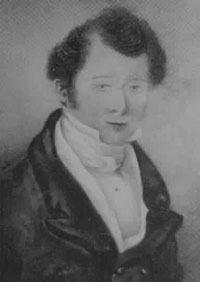
James
Reddy Clendon, British Captain, successful merchant and Consul to the United States,
who played very important drafting and supporting roles for both the 1835 Declaration
of Independence for the Confederation of United Chiefs and the 1840 Treaty of
Waitangi. His signature appears on both New Zealand documents.
February
20th 1840.
U.S. Consul, James Reddy Clendon needs to despatch
a copy of the Treaty of Waitangi to the American Secretary of State in Washington
D.C. to inform the United States Government that a British colony now exists in
New Zealand. Clendon now has sufficient documentation to send a despatch, as C.M.S.
mission printer, William Colenso has, 3-days previously, printed the Treaty of
Waitangi in Maori. He has also, previously, printed Proclamations outlining the
commission of William Hobson from Queen Victoria. All indications, historically,
show that Clendon was deeply involved in the Treaty drafting process during the
last stages and the final draft of the 4th of February was written up, by Busby,
on Clendon's W. Tucker 1833 watermarked paper. On the 4th of February,
Clendon took his own transcript of Busby's final draft and kept it confidential
until the treaty was signed on the 6th of February. He now can inform his superiors
of important, recent political developments in New Zealand that will, eventually,
affect American commerce in the region.
. On the 20th of
February 1840 he sends a despatch (No. 6), which includes a printed Maori Treaty
version, two printed Proclamations and his hand-written English transcript of
the treaty, based upon the final English draft he'd seen on the 4th. He is unable
to guarantee that this transcribed wording constitutes the "official"
English wording, as he doesn't know if further changes were made to the "final
draft" after he last saw it. He, therefore, calls his transcript a translation,
knowing full well it is very close to the original, but says he will have Hobson
issue the "official" English text when the Lieutenant Governor returns
from the Southward.
| BUSBY'S
FINAL DRAFT …4TH OF FEBRUARY 1840. Her
Majesty Victoria, Queen of England in Her gracious consideration for the chiefs
and people of New Zealand, and her desire to preserve to them their land and to
maintain peace and order amongst them, has been pleased to appoint an officer
to treat with them for the cession of the Sovreignty of their country and of the
islands adjacent to the Queen. Seeing that many of Her Majesty’s subjects
have already settled in the country and are constantly arriving; And that it is
desirable for their protection as well as the protection of the natives to establish
a government amongst them. Her Majesty has accordingly
been pleased to appoint me William Hobson a captain in the Royal Navy to be Governor
of such parts of New Zealand as may now or hereafter be ceided to her Majesty
and proposes to the chiefs of the Confederation of the United Tribes of New Zealand
and the other chiefs to agree to the following articles.- Article
first The chiefs of the Confederation of the United
Tribes and the other chiefs who have not joined the confederation, cede to the
Queen of England for ever the entire Sovreignty of their country. Article
second The Queen of England confirms and guarantees
to the chiefs & tribes and to all the people of New Zealand the possession
of their lands, dwellings and all their property. But the chiefs of the Confederation
and the other chiefs grant to the chiefs Queen, the exclusive right of
purchasing such land as the proprietors thereof may be disposed to sell at such
prices as shall be agreed upon between them and the persons appointed by the Queen
to purchase from them. Article Third In
return for the cession of the Sovreignty to the Queen, the people of New Zealand
shall be protected by the Queen of England and the rights and privileges of British
subjects will be granted to them.-
Signed,
William Hobson
Consul
& Lieut. Governor. Now we the chiefs of the Confederation
of the United tribes of New Zealand being assembled at Waitangi, and we the other
chiefs of New Zealand having understood the meaning of these articles, accept
of them and agree to them all.
In witness whereof our names or marks are
affixed. Done at Waitangi on the 4th Feb. 1840.- |
CLENDON’S DESPATCH... 20th of February 1840 Her
Majesty Victoria, Queen of England in Her Gracious consideration for the Chiefs
and the people of New Zealand, and her desire to preserve to them their Lands
and to maintain peace and order amongst them, has been pleased to appoint an officer
to treat with them for the cession of the Sovereignty of their Country and of
the Islands adjacent, to the Queen - seeing that many of her Majesty’s subjects
have already settled in the Country and are constantly arriving: And that it is
desirable for their protection as well as the protection of the Natives, to establish
a Government amongst them. Her Majesty has accordingly been pleased
to appoint me William Hobson, a Captain in the Royal Navy to be Governor of such
parts of New Zealand as may now or hereafter be ceded to Her Majesty and proposes
to the Chiefs of the Confederation of United Tribes of New Zealand and the other
Chiefs to agree to the following Articles. Article First The
Chiefs of the Confederation of the United Tribes and the other Chiefs who have
not joined the confederation, cede to the Queen of England for ever the entire
Sovereignty of their country. Article Second The
Queen of England confirms and guarantees to the chiefs and the Tribes and to all
the people of New Zealand, the possession of their Lands, dwellings and all their
property. But the Chiefs of the Confederation and the other Chiefs grant to the
Queen, the exclusive rights of purchasing such Lands as the proprietors thereof
may be disposed to sell at such prices as may be agreed upon between them and
the person appointed by the Queen to purchase from them. Article
Third In return for the cession of the Sovereignty to the Queen,
the people of New Zealand shall be protected by the Queen of England and the rights
and privileges of British subjects will be granted to them. signed,
William Hobson
Consul and Lieutenant Governor. Now we the Chiefs
of the Confederation of the United Tribes of New Zealand assembled at Waitangi,
and we the other tribes of New Zealand, having understood the meaning of these
articles, accept of them and agree to them all. In witness whereof our Names or
Marks are affixed. Done at Waitangi on the Sixth day of February
in the year of our Lord one Thousand Eight Hundred and Forty. |
Busby's final draft existed before there was
a Maori version of the Treaty, so it can't possibly be a "back-translation".
Clendon's despatch version to the U.S. Secretary of State is virtually identical
in every respect to the final draft by Busby, so it, also, cannot be a back-translation
of the Maori text. The above Clendon text is taken from the microfilm of Clendon's
consular despatches, Bay of Islands, May 27th, 1839-November 3rd, 1846 [microform],
at Auckland Central City Library, held in the Auckland Research Centre. The reference
number is Microfilm 11). The same microfilm can be viewed at Auckland University
Library. See also, Micro 2607, RG59: Despatches from US Consul in the Bay of
Islands & Auckland, National Archives.
March
1st 1840...
Hobson suffers a debilitating stroke, the severity
of which is almost sufficient to end his role as Lieutenant-Governor of New Zealand.
He is returned from the Waitemata District on board HMS Herald and arrives at
the Bay of Islands on the 6th of March. Being incapacitated throughout the month
of March and improving in health only slowly thereafter, he is obliged to temporarily
hand his authority to Willoughby Shortland and Felton Mathew.
U.S.
Consul, James Reddy Clendon applies to the Hobson government to acquire "official"
English and Maori copies of the Treaty of Waitangi - Tiriti O Waitangi for despatch
to the U.S. Secretary of State. The required copies are sent to him by the Colonial
Secretary before the 18th of March 1840 and both Clendon's request and receipt
of the documents are recorded in the Register of Letters of the Colonial
Secretary for March 1840, NZ National Archives.
March
11th.
Surveyor General, Felton Mathew and Hobson's personal
secretary, James Stuart Freeman, visit James R Clendon. It is, possibly at this
time that the treaty copies are officially requested or delivered.
March
13th
Surveyor General, Felton Mathew again visited Clendon
on March 13th ...with whom he had "some business"
to conduct. Perhaps it was on this occasion that the final English draft of
the treaty, formally requested by Clendon, was delivered to him. On this same
day Felton Mathew's, "Deputy Surveyor General", William Cornwallis Symonds,
was sent his large Treaty sheet in the Maori language for his mission to Manukau,
Port Waikato and Kawhia. Perhaps, under his dual roles as, Acting Lieutenant Governor
and Colonial Secretary at the same time, Willoughby Shortland, had assigned Felton
Mathew to deliver Treaty documents to two recipients; one document (Maori) to
his deputy and a set of two documents (Maori & English) to Clendon.
March
29th
The ship, Vincennes, Commodore Charles Wilkes' flagship,
arrives at the Bay of Islands. Already two of Wilkes' Antarctic Exploration squadron
ships are berthed in the bay, the Flying Fish and the Porpoise. Charles Wilkes,
who has just sailed from Sydney, has heard about British annexation ambitions
for New Zealand. He wishes to write a comprehensive report, to be sent in his
despatch number 64, to the U.S. Secretary of State. He immediately engages the
co-operation and services of U.S. Consul, James Reddy Clendon to help him.
April
3rd
Clendon now has in his possession both the official English
and Maori documents. The English one he has been issued is the original "final
draft", written on the 4th of February by James Busby and acquired directly
off Hobson, who kept it with him and read it at the Treaty assemblies at Waitangi
and Hokianga. Clendon also possesses printed Maori copies, done on the CMS Mission
Press on the 17th of February, as well as an "official", hand-written
Maori copy penned by Reverend Henry Williams. Wilkes, seemingly, wishes to undertake
an independent assessment, proving that the Maori text does truly translate to
the "official" English text. He first-off consults a back-translation
by Captain Gordon Brown, which he writes out for despatch to the United States.
He then copies the "official" English text directly from Busby's final
draft. Clendon adds a letter to this despatch, mentioning items he is sending
herein, some of which are now missing from the surviving despatch records.
| BUSBY’S FINAL DRAFT
…4th of February 1840 Her Majesty Victoria, Queen
of England in Her gracious consideration for the chiefs and people of New Zealand,
and her desire to preserve to them their land and to maintain peace and order
amongst them, has been pleased to appoint an officer to treat with them for the
cession of the Sovreignty of their country and of
the islands adjacent to the Queen. Seeing that many of Her Majesty’s subjects
have already settled in the country and are constantly arriving; And that it is
desirable for their protection as well as the protection of the natives to establish
a government amongst them. Her Majesty has accordingly
been pleased to appoint me William Hobson a captain in the Royal Navy to be Governor
of such parts of New Zealand as may now or hereafter be ceided
to her Majesty and proposes to the chiefs of the Confederation of the United
Tribes of New Zealand and the other chiefs to agree to the following articles.- Article
first The chiefs of the Confederation of the United
Tribes and the other chiefs who have not joined the confederation, cede to the
Queen of England for ever the entire Sovreignty of
their country. Article second The
Queen of England confirms and guarantees to the chiefs & tribes and to all
the people of New Zealand the possession of their lands, dwellings and all their
property. But the chiefs of the Confederation and the other chiefs grant to the
chiefs Queen, the exclusive right of purchasing
such land as the proprietors thereof may be disposed to sell at such prices as
shall be agreed upon between them and the persons appointed by the Queen to purchase
from them.
Article Third
In
return for the cession of the Sovreignty to the Queen,
the people of New Zealand shall be protected by the Queen of England and the rights
and privileges of British subjects will be granted to them.-
Signed,
William Hobson
Consul & Lieut. Governor. Now
we the chiefs of the Confederation of the United tribes of New Zealand being assembled
at Waitangi, and we the other chiefs of New Zealand having understood the meaning
of these articles, accept of them and agree to them all.
In witness whereof
our names or marks are affixed. Done at Waitangi on the 4th Feb. 1840.- |
WILKES’ DESPATCH 64 TREATY ... 3rd
of April 1840.
Translation of the Treaty
Her Majesty Victoria, Queen of
England in her gracious consideration for the chiefs and people of New Zealand
and Her desire to preserve to them their lands and to maintain peace and order
amongst them has been pleased to appoint an officer to treat with them for the
cession of their lands country and the islands
adjacent to the Queen seeing that many of Her Majesty’s subjects have already
settled in this country and are constantly arriving and that itis desirable for
the protection of the Natives to establish a Govt. amongst them.
Her Majesty has accordingly been pleased to appoint
me William Hobson a Captain of the Royal Navy to be Governor of such parts of
New Zealand as may now or hereafter be ceided to
Her Majesty and proposes to the chiefs of the confederation of the United Tribes
of New Zealand and the other chiefs to agree to the following articles Article
First The chiefs of the confederation of the United
Tribes and the other chiefs who have not joined the confederation cede to the
Queen of England forever the entire Sovreignty of
their country. Article Second The
Queen of England confirms and guarantees to the chiefs and tribes and to all the
people of N Zealand the possession of their lands, dwellings and all their property.
But the chiefs of the confederation and the other chiefs grant to the chiefs
Queen the exclusive right of purchasing such lands as the proprietors thereof
may be disposed to sell, at such prices as shall be agreed upon between them and
the person apptd by the Queen to purchase from them.
Article Third
In return for the cession of the sovreignty
to the Queen the people of New Zealand shall be protected by the Queen of England
and the rights and privileges of British subjects will be granted to them. Signed
Wm Hobson
Consul and Lt Governor Now the chiefs
of the confederation of the United Tribes of New Zealand being assembled at Waitangi
and we the other chiefs of New Zealand having understood the meaning of these
articles, accept of them and agree to them all. In witness whereof our names or
marks are affixed. Done at Waitangi the sixth day
of Febu in the year of our lord, one thousand eight hundred and forty. Consulate
of the US of America at the Bay of Islands N Zealand.April 3rd 1840.
|
It can be readily seen that Busby's final draft
of the 4th of February 1840 was available to Commodore Charles Wilkes when he
transcribed the text on the 3rd of April, 1840 at James Reddy Clendon's premises.
Although the transcript shows the Commodore has been a bit inattentive or hurried
and left out "of the Sovreignty"
in the Preamble, or has abbreviated
some words, the text is the same. Wilkes has even copied Busby's spelling mistake
for "Sovreignty"
on two occasions, leaving out the telltale "e".
He has also copied Busby's mistake of chiefs
in Article II then corrected it with "Queen"
(See Papers of Charles Wilkes 1837-1847, despatch Number 64, Microfilm
1262, University of Auckland Library pp. 142-145 & 163-168).
From
the foregoing we have positive proof of what the "official" English
text was during the era of Lieutenant Governor William Hobson.
April
11th 1840...
Reverend Robert Maunsell, one of four missionaries
assigned by Hobson to hold Treaty explaining and signing gatherings, conducts
a "Treaty presentation" before 1500 Maori gathered in for their "hui"
business meeting at Waikato Heads. For this meeting Acting Lieutenant Governor,
Willoughby Shortland despatches the government's official, signed off document
(fully in the Maori language) on the 13th of March 1840. Unfortunately, it doesn't
arrive in time for Maunsell to use.
Although the Treaty reading
and discussion is conducted in Maori according to the wording of the "Maori
Treaty of Waitangi" printed text in Maunsell's possession, a mistakenly worded
English version of the treaty has earlier been acquired by Maunsell. This is one
of many strange, variable texts penned by James Stuart Freeman. Unfortunately,
this English version is also an unauthorised text, based upon the rejected Article
II (and other) wording of Busby's preliminary draft (rough notes) of the 3rd of
February 1840.
Reverend Maunsell still awaits his "official"
handwritten Treaty document, which has yet to be delivered by Captain W.C. Symonds.
It finally arrives 3-days too late.
The defective document
in English that Maunsell does possess on the day, unlike the much smaller, C.M.S
mission printed document in Maori also available, has plenty of room at the bottom
to receive signatures and is, therefore, used as the paper upon which the "overflow"
of signatures and marks of the chiefs are affixed. The formal presentation to
the chiefs is fully conducted in Maori from the CMS mission printed sheet.
The
defective English treaty sheet, in conjunction with the Maori C.M.S. printed text
for oral presentation, is again used on the 26th of April, when seven more signatures
are added at Manukau Heads. By this time, W.C. Symonds has sent the "official"
government issued document onward by messenger to Kawhia and returned to Manukau
with Maunsell's "make-do" documents for his third attempt at getting
signatures there. During the first two attempts he used the "official"
government issued and authorised treaty document, which was handwritten fully
in the Maori language.
Hobson, when he returns to duty, accepts
the signatures on both "make-do" treaty sheets; those appearing on the
larger, second, English sheet simply being additional, overflow signatures, following
on from the first ones affixed to the Maori document. What has been conveyed to
the chiefs was a "standard" missionary presentation of the official
Maori text and Hobson applies his seal accordingly to give the signatures on a
"make-do" treaty document validity.
Maunsell's
rushed (to take advantage of an already scheduled hui) departure from the standard
treaty procedure, done with the purest of intentions on April 11th 1840, has been
deliberately misconstrued to provide the "shaky and shonky" legal foundation
for most of the present day "Treaty Industry" exploitation and plunder.
The defective English text, which is simply another strange "Formal Royal
Style"compilation by James Stuart Freeman, of rough treaty draft notes from
the 1st to the 3rd of February, has now replaced the Maori Treaty of Waitangi
in authority. This strange, unauthorised English text has graduated into becoming
our only official Treaty wording, due to the deliberate inaction of our establishment
historians and "turn a blind eye" tactics of our judiciary. New Zealanders
have, in recent decades, been subjected to gross deception and cruel "treaty
fraud".